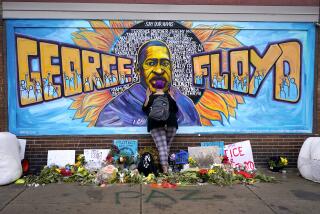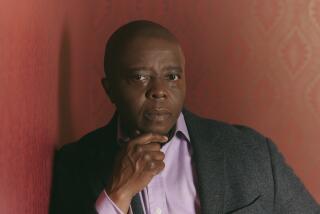Hope, Caution in Cincinnati
- Share via
CINCINNATI — The rhetoric on this tense anniversary is upbeat. A year after race riots tore at this city, politicians--white and black--are hailing a new agreement to address long-simmering complaints that police here brutalize minorities.
There is a 60-page police reform plan that promises tight controls on the use of choke holds, dogs and Mace to subdue suspects. There is talk of a new era. “A historic moment,” says Mayor Charlie Luken. “A turning point for this city.”
But off in the corner of the ornate council chambers, Police Chief Tom Streicher sits apart, his uniform crisp, his face taut. He has prepared a sound bite praising the reforms as “fair and progressive.” It’s clear, though, that he does not think much of some of them.
Take the civilian watchdog panel, a much-touted reform that will, for the first time, give citizens power to investigate allegations of police misconduct. The chief can see little point to that. In fact, he considers it mainly a public relations sop, to “make the public feel better.”
He and several of his top deputies insist as well that all the use-of-force reforms will not add up to much real change.
Their take: Police have been following proper procedures all along. So the package released last week in council chambers “will not fundamentally change what our officers are doing,” said Assistant Chief Richard Janke, who commands the patrol bureau.
The gulf in expectations--between politicians promising a new Cincinnati and police brass saying not much needs to change--underscores the tensions that persist here a year after the riots.
There are other indications as well:
* Charging the city with “systemic racism,” some black leaders have pressed a boycott of downtown businesses that has cost Cincinnati at least $10 million so far.
* Bill Cosby, Whoopi Goldberg, Wynton Marsalis and several other black entertainers have honored the boycott by canceling shows here. The Progressive National Baptist Convention scrapped plans to have 10,000 delegates convene in Cincinnati. And patrons of downtown restaurants have at times been greeted by protest signs chiding “Eat, drink and be racist.”
* Thousands of demonstrators are expected to march downtown this morning to mark the day one year ago when 19-year-old Timothy Thomas was shot dead as he fled a police officer in the middle of the night. Thomas was wanted on multiple warrants, mostly for traffic violations.
His death sparked three days of street violence--the worst racial unrest in Cincinnati since Martin Luther King Jr. was assassinated in Memphis, Tenn., in 1968.
City officials worry that the protest march could be volatile. “I don’t know how it’s going to go,” Mayor Luken said uneasily.
In his view, and the view of many other civic leaders, the city has taken enormous strides in the last year. There have been initiatives to help blacks start their own businesses and to steer more construction contracts to minorities. The private sector has created hundreds of summer jobs for teens who complained of idle days on dangerous streets.
The city has pledged $50 million to clean the decrepit neighborhoods where many blacks live in despair. And the school board and the state will spend nearly $1 billion over the next decade to replace dozens of dilapidated buildings.
“We should start seeing tangible changes in the neighborhoods soon,” promised Vice Mayor Alicia Reece.
In a mostly black neighborhood north of downtown, the Rev. Peterson Mingo already has seen major change.
He reports with delight that police officers there have been making a conscious effort to reach out and to relax their authoritarian image. “A philosophical and strategic shift,” Lt. Col. Rick Biehl called it.
Officers have started patrolling on foot more often so they are more accessible. They have worked with civilians to develop strategies to weed out drug pushers. The local commander even reassigned several officers who Mingo complained were harassing black youths.
The other day, Mingo said, he saw several neighborhood kids run up to two cops, clamoring to be photographed with them.
“There’s been a lot of progress,” he concluded. “A whole lot of progress.”
To encourage such progress elsewhere in the city, the federal government has pledged to train thousands of Cincinnati civilians on how to cooperate with police to fight crime. And the police have pledged to use Mingo’s neighborhood as a model for improving relations.
“Do we have a long way to go? Absolutely. But we’ll get there,” said Tom Cody, the chairman of a civic improvement panel created after the riots.
That optimistic outlook received a boost Wednesday when city leaders unveiled the proposals for police reform.
The document was negotiated over 10 months by police, elected officials, black leaders, the American Civil Liberties Union and the U.S. Department of Justice to settle a lawsuit alleging decades of racist policing.
If all parties ratify it, the lawsuit will be dismissed and a federal judge will appoint a monitor to make sure the police carry out every condition.
The promise of a federal monitor appeals to many wary citizens who say they no longer trust the police or the city to make good on promises of reform.
“I really don’t have much faith in any of them,” said Brenda Owensby, whose son was asphyxiated in a scuffle with police 17 months ago. “Saying and doing are two different things.”
“So many city leaders just don’t get it,” agreed attorney Paul DeMarco, who sits on a civilian panel that is supposed to review police misconduct but has no teeth.
“There is a deeply entrenched attitude, insidious in Cincinnati, that the police are above the law,” DeMarco said. “My confidence is in the federal court, period.”
There is reason for such wariness. In 1968 and 1979 and 1981, in 1987 and again in 1995, federal and local panels were set up to address persistent concerns of racism and police misconduct. In every case, the investigators found troubling patterns.
Reports were written, recommendations made. Landmark reforms were pledged. Still, the problems endured.
“Are we going to go through the same cycle again now?” asked the Rev. Paula Jackson.
Luken promises that this time it will be different.
The boycott will wither, he says. The police will earn public trust. The crumbling neighborhoods will be rebuilt. And Cincinnati will heal.
“The city’s been getting a bad rap, obviously. This has been a difficult year for everyone,” he said. “But if we keep our eye on the ball and keep moving, we’ll eventually get where we have to go.”
More to Read
Sign up for Essential California
The most important California stories and recommendations in your inbox every morning.
You may occasionally receive promotional content from the Los Angeles Times.













